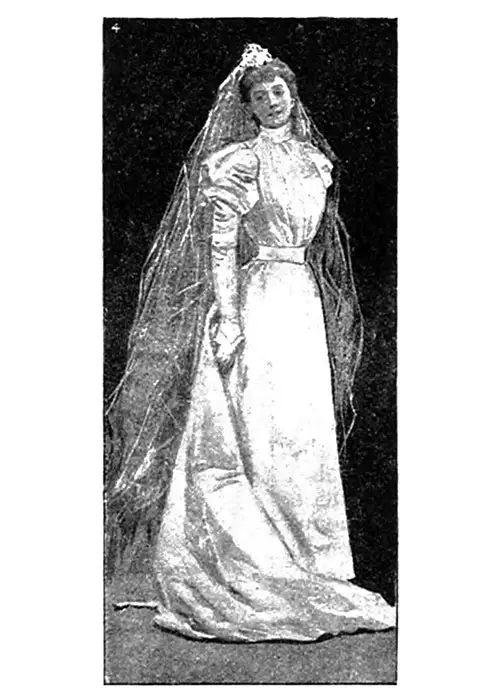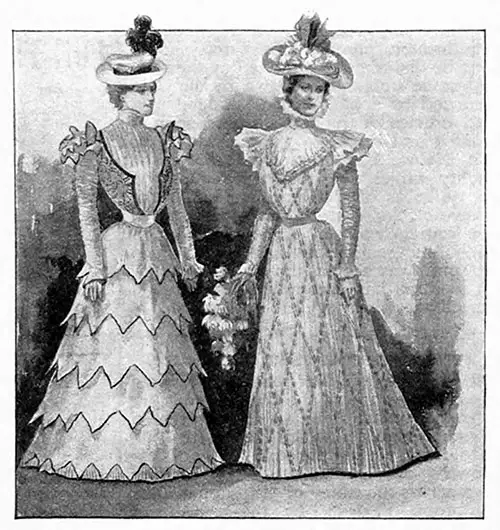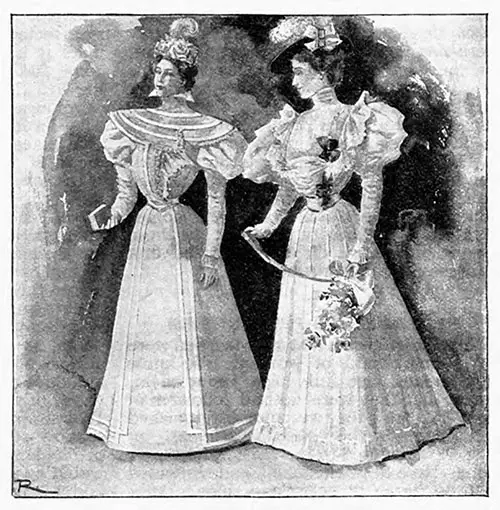A Bride’s Moderate Trousseau in 1897
By Isabel A. Malian
Illustrations by Ethel Rose
While only two or three people know in what month the wedding day will be, the prospective bride and her mother are giving their thoughts to the making of the lingerie.
Taking it for granted, then, that the average girl has the usual amount of underwear, she will have a plentiful supply for the future if she adds to that which she already possesses six new pieces of each kind. As to stays, three pairs will be enough.
One nice pair of walking shoes, one pair of heavy boots for rainy weather, a pair of dress slippers, a pair of bedroom slippers, a pair of low patent-leather shoes, and a pair of low russet shoes will be needed.
As for stockings, six pairs, either of lisle or cotton, with the one silk pair to wear with your wedding gown, will be a sufficient supply.
A dozen new handkerchiefs, having narrow hemstitched borders, with the initials of your maiden name in white letters in the corner of each, will be an acceptable and dainty addition to the trousseau.
What the Bride Will Wear
You have decided that you will be married in white satin. Then, too, you are to be, as the children say, “a real bride,” for you will wear a veil. The most becoming and the most suitable veil for a bride is that of tulle, which very full and reaches almost to the edge of the train in the back.
The wearing of the veil over the face is going out of fashion. However, if you fancy having it arranged in that way, then the professional hair-dresser, having a piece of tulle at her command, will, after allowing it to cover your train, drape it in a bunch on top of your head.
Let it fall forward almost to the edge of your skirt, and then where it seems fullest, she will split the tulle clear up above your forehead.
Through this part, just above your front hair, she will run a string, and when the time comes for throwing the veil back, which is a most troublesome thing to do, the maid of honor will merely slide it, curtain fashion, to each side; the string will not show on your hair, and yet when the veil is over your face the opening will not be visible in the fullness of the folds.

White Satin Wedding Gown and Veil
The wedding costume, veil, and all, is shown in the picture above. The gown is of white satin—that beautiful cream white that you admired so much—and it is made with a full but plain skirt.
The tulle veil, not worn over the face, is fastened to the high coiffure (the hair must always be arranged high when a veil is worn) under a cluster of orange blossoms.
The long, pointed sleeves, prettily full at the shoulders, are finished with frills of real point lace, and embellishment in harmony flares out at the back of the crush collar. The crush belt is laid in soft folds and does not show its fastening, which is at the side.
You will be wise in having no orange blossoms on your gown. They would have to be removed at once after the wedding, since there is only one time in your life when you may wear orange blossoms.
The Maid of Honor's Gown

Maid of Honor in Pink Silk Muslin - Bridesmaid's Frock of Pale Green
The maid of honor shown in illustration shows the fancy that exists just now for a bit of black to bring out the color of her gown and intensify its contrast with that of the bride's.
This lady-in-waiting wears a Frenchy-looking gown of pink silk muslin, which is made over a white foundation. The skirt, which is not very wide, is covered with five-pointed flounces, a narrow plaiting being at the extreme edge.
Each flounce is bound with narrow black velvet ribbon. The full bodice of the soft silk is made to look elaborate by a bolero, which is attached to it at the arm and under-arm seams and goes under the belt; it is of pink velvet, having an elaborate design wrought upon it in black spangles, while its edges are bound with black velvet.
The sleeves are wrinkled in mousquetaire fashion, come far over the hands, and have epaulets above the shoulders in harmony with the frills on the skirt.
The hat has a brim of rough white straw and a Tam crown of pink velvet. At the left side, where it is raised slightly, are a bunch of pink roses and three black tips.
Gowns for The Bridesmaids
Fashion demands that bridesmaids should be dressed in some of the faint tints, and also in white in honor of the bride. Any fabric, more or less light, of course, out of which a picturesque costume can be designed, is counted good form.
A costume which might be worn when there are several bridesmaids is that assumed by the young girl standing next to the maid of honor. The foundation of her outfit is pale green China silk: over this is a plissé skirt and blouse bodice of coarse fishnet, which has a baby ribbon of green velvet run through the meshes diagonally.
The yoke, which is full, is of white chiffon, and, like the fish-net, is over the green silk. The sleeves, full and finished with pretty frills, have ruffles of chiffon over the shoulders.
At the top of the blouse portion of the bodice is a puckered heading of the chiffon, each little row of puckers being finished with a narrow velvet ribbon. The picturesque hat is of fine white Leghorn.

Bride's Frock of White Taffeta and Bridesmaid in Yellow and Black
A Pretty Costume Made of Chiffon
While it is permitted that one may be married in a traveling gown, almost every woman prefers a costume a little dressier, and which can be changed for the traveling gown. It is little more trouble since few brides dare to go away wearing a new traveling dress.
So since there is a change of gowns why should not the bride's frock be all white? Pretty costumes have been made of chiffon, and with them has been worn a small corsage made of flowers.
Her Wedding Gown of White Taffeta
A cute costume that is not expensive, and to which much wear may be given, is made of white taffeta. The distinctive charm of this frock consists in the perfect cut of the skirt and the simple but artistic arrangement of the trimming on the bodice.
The cape-like yoke and skirt are trimmed with heavy, but perfectly plain, white silk braid. A fan-like jabot of real lace decorates the bodice below the yoke and has for its heading what is known as a “pinching '' of taffeta.
The sleeves are slightly puffed at the shoulders, shape in to fit the arms, and are decorated with lace like that on the bodice. The small, but becoming corsage is of white rosebuds with a white aigrette just in front.
The Bridesmaid in Yellow and Black
The bridesmaid accompanying this bride is sufficiently dark to wear that combination in colors that are most fashionable for bridesmaids in England this season.
Her gown is pale yellow chiffon, laid in plaits which are stitched down to about six inches below the waist, and from there fly loose, having a narrow frill as the edge finish.
The bodice is a draped one, with a frill of chiffon so arranged that a square effect is produced, while on the left side are placed two cabbage bows of black velvet ribbon. The sleeves are slightly puffed on the shoulders, shape in mousquetaire fashion to fit the arms, and have the usual soft frill finish, which instance, of chiffon.
The pictured hat is of black velvet, turned up at one side under yellow tips that are firmly positioned, fastened by loops of yellow ribbon and a jet buckle. The bouquet is of yellow chrysanthemums, its long ribbons being white.
It cannot be doubted that the pictured hat will obtain for bridesmaids all during the coming season and that oftenest of all these hats will be either of black velvet or black felt. Still, even in the depth of winter, we are beginning to follow the fashion of our English cousins and allow, at least to a bridal party, straw hats.
Somebody has said that it costs a bridesmaid more to get a picture hat than it does to buy her costume, since the silk for it may be purchased for from seventy-five cents to a dollar a yard and only fourteen yards are required, while a picture hat, bought is, in this from a milliner who is supposed to be especially artistic, may cost a great deal.
Choosing Simple, Sensible Visiting Gowns
The girl who has a fortune at her command needs no suggestions, but the girl who has to think out the wisdom of every dollar spent on her trousseau is the one who asks for advice.
Taking it for granted, then, that you will live a more or less social life, having your day at home and visiting your friends, and occasionally going to hear good music, you can decide what you will need exactly.
First of all, freshen all the gowns you possess, then you know their possibilities; then, I would advise one handsome silk dress, combined, perhaps, with velvet, and having, to go with it, two bodices—one for wear when you are visiting, the other to be used when rather more elaborate dress is required.
Have one simple, but smart looking, wool dress for street wear; if needed, you might better omit your visiting costume than this. A black skirt, either of moiré, silk, or satin, will be useful since with it there can be worn any number of elaborate bodices.
Then you will want, also, a comfortable wrapper, to wear in no place except in your own room; two pretty, well-fitting, house dresses; a coat suited to the season; a wrap that is a little more elaborate, if you can afford it; but do not make the mistake, so often made, of buying clothes that are not suited to your position in life, or, what is equally as bad, of buying such an elaborate wardrobe that it will go out of fashion.
Mallon, Isabel A., "A Bride's Moderate Trousseau," Illustrated by Ethel Rose, in The Ladies' Home Journal, Philadelphia: The Curtis Publishing Company, Vol. XIV, No. 9, August 1897, p. 19.
Editor's Note: Some terminology used in the description of women's clothing during the 1800s and early 1900s has been changed to reflect more modern terms. For example, a women's "Toilette" -- a form of costume or outfit has an entirely different common meaning in the 21st century. Typical terms applied to "toilette" include outfit, ensemble, or costume, depending on context.
Note: We have edited this text to correct grammatical errors and improve word choice to clarify the article for today’s readers. Changes made are typically minor, and we often left passive text “as is.” Those who need to quote the article directly should verify any changes by reviewing the original material.

